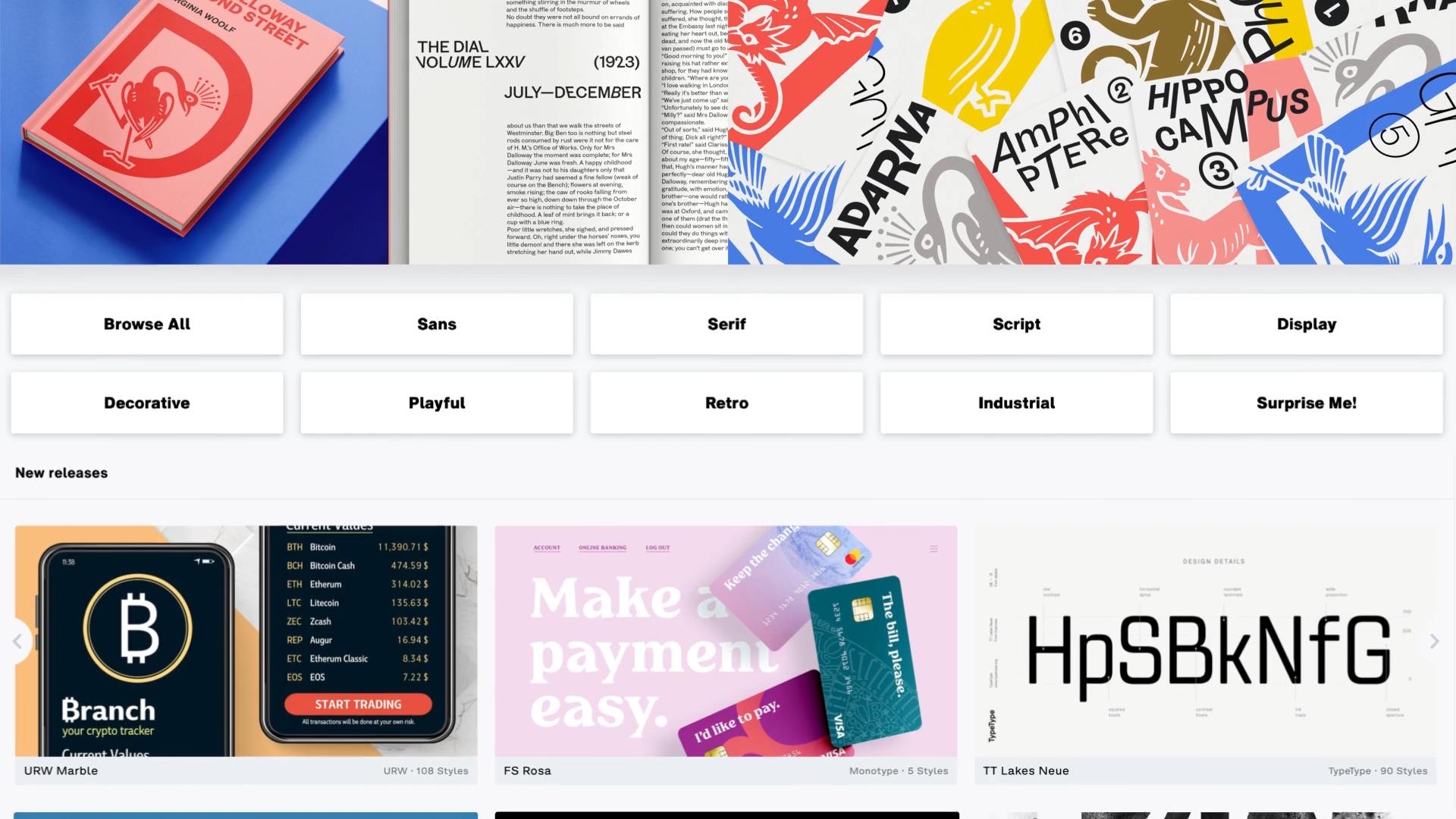
Monotype FontsAPI: Complete Buyer's Guide
Enterprise standard for typography management infrastructure
Monotype FontsAPI represents the enterprise standard for typography management infrastructure, delivering AI-enhanced font discovery and comprehensive licensing governance rather than generative font creation. The platform serves as a centralized typography command center for organizations managing complex brand systems across multiple digital platforms and global markets.
Market Position & Maturity
Market Standing
Monotype FontsAPI occupies a dominant position in the enterprise typography management market, leveraging decades of foundry relationships and licensing expertise to create substantial competitive moats. The company's 250,000+ font inventory and partnerships with 2,000+ foundries represent the industry's most comprehensive commercial typography ecosystem, significantly exceeding alternatives like Google Fonts' free offerings or Adobe's more limited licensed collection[49][55].
Company Maturity
Company maturity indicators include comprehensive API documentation, established OAuth 2.0 authentication systems, and proven integration capabilities with Adobe Creative Cloud environments[39][42][52]. The platform's technical infrastructure supports enterprise-grade deployments with documented 3-6 month implementation timelines for complex integrations, indicating operational maturity and deployment experience[52].
Industry Recognition
Industry recognition appears through customer testimonials emphasizing reliability and documentation quality, with Sufio's CEO calling the platform "reliable and very well-documented" and United Prime describing it as "one of the most efficient and cost-effective font platforms we have ever used"[51][53].
Strategic Partnerships
The platform's enterprise-grade infrastructure includes partnerships with 2,000+ foundries, providing licensing certainty unavailable through free alternatives like Google Fonts[49][55].
Longevity Assessment
Longevity assessment benefits from Monotype's established position in the typography industry and comprehensive foundry partnerships that create switching costs for competitors attempting to replicate the licensing infrastructure. The platform's enterprise focus and proven deployment capabilities suggest continued viability, though competitive pressure from Adobe's superior AI generation capabilities and Google's accessibility advantages requires ongoing strategic adaptation[40][43].
Proof of Capabilities
Customer Evidence
Enterprise deployment validation comes from documented customer implementations across diverse industries. Bauer Media's 3-month proof-of-concept successfully centralized 10,000+ fonts across 18+ applications using custom Adobe InDesign integration, with Patrick Renner emphasizing collaborative vendor engagement "from the very first day"[52]. This case demonstrates complex enterprise integration capabilities and vendor partnership effectiveness.
Quantified Outcomes
Educational sector adoption shows through United Prime Educational Publishing's 6-week onboarding that achieved 30% reduction in font procurement cycles while maintaining compliance across their publishing operations[53].
Case Study Analysis
SaaS platform success appears through Sufio's 8-week integration deploying 40,000+ fonts to their invoicing platform, with CEO Norbert Ordog citing "reliable and very well-documented" APIs[51].
Market Validation
Market validation appears through the platform's 250,000+ font inventory and partnerships with 2,000+ foundries, representing the industry's most comprehensive commercial typography ecosystem[49][55].
Competitive Wins
Competitive wins emerge through differentiated positioning against free alternatives like Google Fonts that lack enterprise licensing protection, and generative competitors like Adobe Firefly that emphasize creation over management[40][43].
Reference Customers
Documented success with major organizations including Bauer Media, United Prime Educational Publishing, and Sufio, spanning publishing, education, and SaaS sectors[51][52][53].
AI Technology
Monotype FontsAPI's technical foundation centers on intelligent curation and management rather than generative AI creation, differentiating it from competitors like Adobe Firefly that emphasize font generation capabilities[43]. The platform's machine learning capabilities include visual font recognition through image uploads, semantic search using descriptive tags, and automated font pairing suggestions that enhance discovery workflows without replacing human creative control[39][43][54].
Architecture
Architecture and deployment emphasize enterprise-grade infrastructure with OAuth 2.0 authentication flows and scoped permissions management, though this complexity creates implementation barriers with common scope permission errors documented in support materials[41][42]. The platform's CDN restrictions prevent third-party hosting, creating vendor dependency considerations while ensuring performance and security standards[42][54].
Primary Competitors
Primary competitors include Adobe Firefly for generative AI capabilities, Google Fonts for cost-effective alternatives, and Canva for SMB accessibility[40][43].
Competitive Advantages
Competitive advantages center on the industry's largest commercial font inventory with 250,000+ fonts and comprehensive licensing infrastructure through 2,000+ foundry partnerships[49][55]. This scale provides legal protection and font availability that free alternatives cannot match, while licensing management capabilities exceed generative competitors' offerings.
Market Positioning
Market positioning establishes Monotype as the enterprise licensing leader facing competition from Adobe's superior AI generation and Google's accessibility advantages. The defensive differentiation through compliance automation remains strong, though AI capabilities lag industry innovation leaders[43].
Win/Loss Scenarios
Win scenarios favor Monotype for organizations requiring licensing compliance, global deployment capabilities, and enterprise-grade integration. Documented success with Bauer Media, United Prime, and Sufio validates effectiveness for complex enterprise typography governance[51][52][53]. Loss scenarios occur when organizations prioritize generative creation over management, operate with limited budgets, or lack technical resources for complex implementation. Adobe Firefly better serves creative generation needs, while Google Fonts suits budget-conscious implementations[40][43].
Key Features

Pros & Cons
Use Cases
Integrations
Featured In Articles
Comprehensive analysis of AI Typography Tools for AI Design for AI Design professionals. Expert evaluation of features, pricing, and implementation.
How We Researched This Guide
About This Guide: This comprehensive analysis is based on extensive competitive intelligence and real-world implementation data from leading AI vendors. StayModern updates this guide quarterly to reflect market developments and vendor performance changes.
56+ verified sources per analysis including official documentation, customer reviews, analyst reports, and industry publications.
- • Vendor documentation & whitepapers
- • Customer testimonials & case studies
- • Third-party analyst assessments
- • Industry benchmarking reports
Standardized assessment framework across 8 key dimensions for objective comparison.
- • Technology capabilities & architecture
- • Market position & customer evidence
- • Implementation experience & support
- • Pricing value & competitive position
Research is refreshed every 90 days to capture market changes and new vendor capabilities.
- • New product releases & features
- • Market positioning changes
- • Customer feedback integration
- • Competitive landscape shifts
Every claim is source-linked with direct citations to original materials for verification.
- • Clickable citation links
- • Original source attribution
- • Date stamps for currency
- • Quality score validation
Analysis follows systematic research protocols with consistent evaluation frameworks.
- • Standardized assessment criteria
- • Multi-source verification process
- • Consistent evaluation methodology
- • Quality assurance protocols
Buyer-focused analysis with transparent methodology and factual accuracy commitment.
- • Objective comparative analysis
- • Transparent research methodology
- • Factual accuracy commitment
- • Continuous quality improvement
Quality Commitment: If you find any inaccuracies in our analysis on this page, please contact us at research@staymodern.ai. We're committed to maintaining the highest standards of research integrity and will investigate and correct any issues promptly.